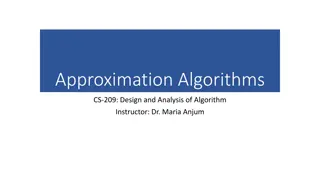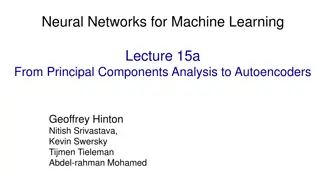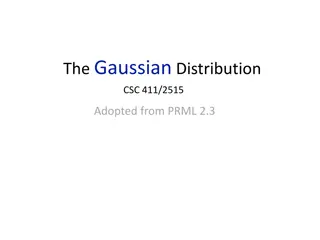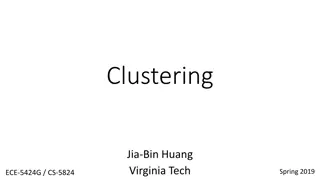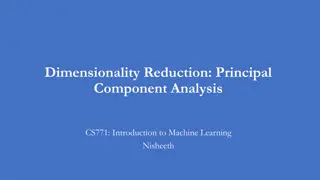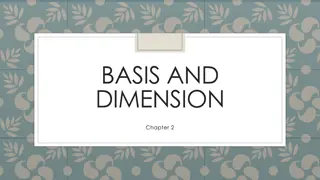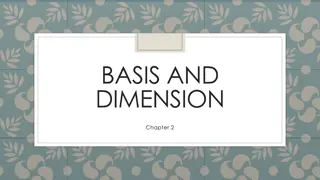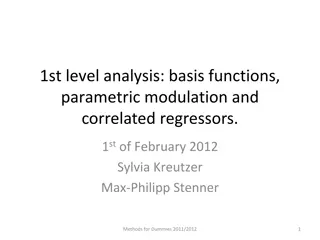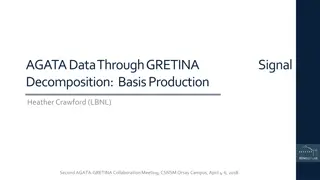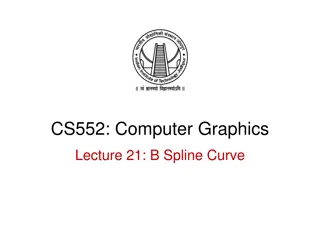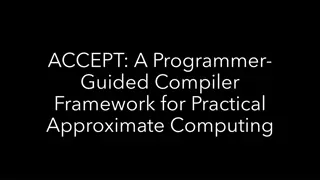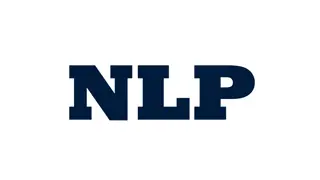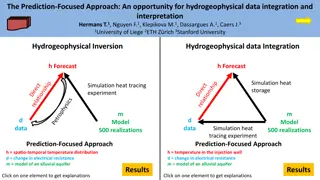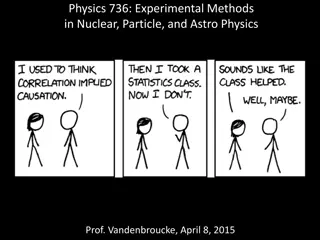Functional Approximation Using Gaussian Basis Functions for Dimensionality Reduction
This paper proposes a method for dimensionality reduction based on functional approximation using Gaussian basis functions. Nonlinear Gauss weights are utilized to train a least squares support vector machine (LS-SVM) model, with further variable selection using forward-backward methodology. The method is experimented with food industry datasets, showing effective reduction without loss of precision. Comparisons are made with PLS and PCR models. Optimisation of basis function locations and widths is conducted for improved fitting accuracy. Variable selection is performed using a faster forward-backward algorithm for optimal feature subsets.
Download Presentation

Please find below an Image/Link to download the presentation.
The content on the website is provided AS IS for your information and personal use only. It may not be sold, licensed, or shared on other websites without obtaining consent from the author.If you encounter any issues during the download, it is possible that the publisher has removed the file from their server.
You are allowed to download the files provided on this website for personal or commercial use, subject to the condition that they are used lawfully. All files are the property of their respective owners.
The content on the website is provided AS IS for your information and personal use only. It may not be sold, licensed, or shared on other websites without obtaining consent from the author.
E N D
Presentation Transcript
abstract In this paper, we propose a method that is based on functional approximation using Gaussian basis functions. The basis functions are data using nonlinear Gauss weights are then used as training data to build a least squares support vector machine (LS utilise further selected using forward methodology is experimented with three datasets originating from the food the proposed method can be used for dimensionality reduction without loss of precision. In this paper, we propose a method that is based on functional approximation using Gaussian basis functions. The basis functions are optimised data using nonlinear Gauss Newton algorithm. The fitting weights are then used as training data to build a least- - squares support vector machine (LS- -SVM) model. To utilise the reduced data dimension, relevant variables are further selected using forward backward (FB) selection. The methodology is experimented with three datasets originating from the food industry.The the proposed method can be used for dimensionality reduction without loss of precision. optimised to accurately fit the spectral Newton algorithm. The fitting to accurately fit the spectral SVM) model. To the reduced data dimension, relevant variables are backward (FB) selection. The industry.The results show that results show that
introduction For comparison partial least squares (PLS) and principal component regression (PCR) models are also experimented.
GAUSSIAN BASIS GAUSSIAN BASIS
Optimisation Optimisation of locations and widths of locations and widths Since the basis functions are differentiable, the locations and widths can be optimised for a better fit. The average fitting error of all functions is obtained by averaging Equation (2) over all of the sample inputs i = 1, . . . , N. Using the matrix notation given above, it can be formulated as
FORWARD SELECTION FORWARD BACKWARD VARIABLE SELECTION BACKWARD VARIABLE The most simple variable selection method is exhaustive search, that is trying out all the possible variable combinations. However, exhaustive search quickly becomes impossible as number of algorithm of variables is found In FB algorithm, each variable can be in two states: on , meaning that or off initial state vector ( algorithm proceeds by flipping the state at a time and by computing the corresponding measure The most simple variable selection method is exhaustive search, that is trying out all the possible variable combinations. However, exhaustive search quickly becomes impossible as number of variables grow. FB selection is a algorithm but of variables is found. . In FB algorithm, each variable can be in two states: on , meaning that it belongs to the set of selected variables or off meaning that initial state vector (states of algorithm proceeds by flipping the state of each at a time and by computing the corresponding error measure. . variables grow. FB selection is a faster but there is faster there is no guarantee that the optimal set no guarantee that the optimal set it belongs to the set of selected variables meaning that it is discarded. Given a certain states of all variables), the it is discarded. Given a certain all variables), the of each variable error variable
Datasets 1)Tacator: range of fat content 0.9_49.1% Datasets 100 learning CL Training set of tacator 172 Test CT 43 256 215 Learning CL 2)Win:Range of alcohol content 7.48_18.5% 94 34 Test CT 124
3)Orange juice:range of Saccharose content: 0_78.8 Training set of juice Training set of wine 700 Learning CL Test CT 146 67 213
Error measures Error measures In the training phase, 10-fold cross-validation is used. Denoting the 10 subsets of CL as CL,1, CL,2, . . . , CL,10, the cross-validation MSE is defined as where yi represents the estimated concentration and each MSEV,j is associated to a model that has been trained with the set CL \ CL,j The generalisation performance is estimated by simulating the prediction model on the test set CT . However, since the test sets are rather small, the MSET is not very reliable error measure and thus the validation errors must also be taken into consideration when interpreting the results.
Selecting number of basis functions The maximum number of functions was 25, 36 and 35 for Tecator, wine and juice datasets, respectively. However, it should be noted that the Gaussian basis functions provide a more accurate fit that B-splines of the same dimension. The number of latent variables (in PLS) and number of pc (in PCA) were selected using the same 10-fold cross-validation. The number of basis functions was also selected using the same criterion. Furthermore, to illustrate the effect of the Gaussian fitting, all the three models, PCA, PLS and LS-SVM, were trained with the raw spectral data as well. Selecting number of basis functions
Note: learning sets were randomly permutated. The same permutation was used in all tests to obtain fully comparable results
FB variable selection FB variable selection In the case of the Tecator dataset, the number of Gaussian basis functions was 16, out of which 10were selected by the FB process. Using the B-spline basis, 24 functions were chosen, out of which 11 were selected. For the Wine dataset, Gaussian fitting resulted in 13 variables out of which 8 were selected while B-spline fitting resulted in 35 variables out of which 15 were selected. The results obtained with the juice dataset are similar: Gaussian fitting resulted in 32 variables out of which 9 were selected and B-spline fitting resulted in 30 variables out of which 10were selected. Thus in all the cases spectra were compressed remarkably, resulting in only 8 15 significant variables
RESULTS RESULTS The prediction errors obtained with the three datasets are presented in Tables I III.
Tacator Using the Gaussian fitting improves the performance even more. However, combining FB variable selection to the Gaussian+LS-SVM model decreases the validation error but increases the test error.Since both the learning set and the test set are small, it is not clear whether this is due to over fitting: the validation error is an average of 10 separate estimates, so theoretically it should be more accurate than the test error. On the other hand, however, the validation error has been minimised during the training process, so itis not independent and thus not as reliable as the test error.
Wine all the models, including plain PLS and PCR, give good results which suggests that the problem is highly Linear.Despite the linearity of the problem,combining the function fitting with LS-SVM model yields good results. Again,considering both MSEV and MSET one can conclude that the B-spline+LSSVM+FB is the best model. However, the Gaussian+LS-SVM +FB results in significantly smaller number of variables while the performance remain satisfactory.
juice juice Among the plain regression models, plain PLS performs the best. Gaussian+LS-SVM+FB and B-spline+LS-SVM+FB give slightly better results, but considering the size of the dataset, the difference can hardly be considered as significant. Therefore, due to the simplicity of PLS, one can conclude that plain PLS is the best model.
conclusion Gaussian fitting combined with LS-SVM model performed best on the Tecator dataset and it was observed that the Gaussian fitting tends to compress the data more than the B-splines. However,B-splines gave better results in the wine dataset. Furthermore,the results obtained with the juice dataset suggest that in some, rather difficult cases, the function fitting cannot improve the prediction performance. Therefore, the choice of method depends on the dataset and the goal of the analysis. the importance of learning set and test set size becomes very clear. Therefore, in future the methodology should be tested on various large datasets in order to be able to obtain more reliable performance measures.





